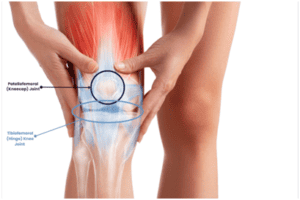Physiotherapy Approaches for Effective Patellofemoral Pain Treatment
Patellofemoral pain syndrome (PFPS) is one of the most common causes of knee pain seen in clinical practice by Physiotherapists. It affects women nearly twice as much as men and is usually seen in adolescents and adults up to the age of 30.
Patients with PFPS often reportgradual onset pain at the front of their knee that is aggravated by increased load through a bent knee in activities such as running, jumping, squatting, and going up and down stairs.
To understand PFPS, it is important to understand the anatomy of the knee joint. Your knee is made up of two joints:
- Tibiofemoral Joint = Hinge Knee Joint = the joint between your femur (thigh bone) and tibia (shin bone).
- Patellofemoral Joint = the joint between your femur (thigh bone) and patella (kneecap).
Your kneecap sits in a groove on your femur to make up the patellofemoral joint. When you bend and straighten your hinge knee joint, your kneecap moves up and down in the groove on your femur.

There are many different structures within the patellofemoral joint, including bones, cartilage, ligaments, bursae (fluid-filled sacs designed to decrease friction), nerves, joint capsule, and joint fluid. In PFPS, one or several structures in the patellofemoral joint become irritated and inflamed, resulting in pain.
There are many factors that have been proposed to contribute to the development of PFPS. The 4 main categories are:
- Static Alignment:
The shape and alignment of your femur, kneecap and feet, and hip and knee muscle tightness can affect where your kneecap sits in the groove on your thigh bone, potentially altering your biomechanics when you then start to move.
- Dynamic Alignment:
Muscle weakness, ligamentous laxity and foot position can also affect how your kneecap moves in its groove when your move your knee.
Both static and dynamic misalignment or imbalance can result in altered loading through various structures in your patellofemoral joint, causing pain.
- Overuse/Overtraining/Overload:
Repetitive loading of your patellofemoral joint, even in the absence of any static or dynamic misalignment, can contribute to the development of PFPS. If you have recently started or have increased any activities such as running, going up/downstairs and squatting, this is likely to have contributed to the development of your PFPS. Overuse is the most definitive cause of PFPS.
- Trauma:
Direct trauma (e.g. a fall) onto your kneecap or near your patellofemoral jointcan also damage structures in that area, resulting in PFPS.
If you think you have PFPS, the good news is that All Care Physiotherapy can help you! We are conveniently based in the Brisbane CBD and are well equipped to not only give you treatment for your knee pain but also address the cause.
As there are many contributing factors to the cause of your PFPS, it is vital that you come in for an assessment so our fabulous Physiotherapists can determine the reasons you have developed this pain.
All Care Physiotherapists have many tools that they can use to treat PFPS, including:
- Soft tissue massage
- Dry needling
- Joint mobilisations
- Ultrasound
- Shockwave therapy
- Taping
Exercises to address the dynamic imbalances that have contributed to the development of your pain.
